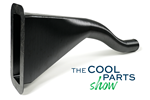3D Printing Solutions to Support Investment, Sand Casting
3D Systems is highlighting a design strategy for better investment casting patterns, as well as a new machine suitable for the production of patterns for sand casting.
Share
Read Next
Additive manufacturing technology supplier 3D Systems is showcasing two developments that enable the 3D printing of tooling for investment casting and sand casting, utilizing two different polymer printing processes.
To support investment casting, the company is launching QuickCast Air, a new design strategy for 3D printing investment casting patterns with stereolithography (SLA) equipment. Building on its existing QuickCast build style methodologies for investment casting patterns, this new strategy helps to reduce material consumption, increase throughput and reduce draw times. Parts drain better and ash content is reduced using this strategy, the company says, bringing better investment casting results.
Of interest for sand casting, 3D Systems is displaying the new EXT 800 Titan Pellet, a smaller version of its extrusion-based EXT 1070 and EXT 1270 Titan Pellet machines. This compact 3D printer is more cost-effective and occupies a smaller footprint than previous models in the EXT line, making it suitable for foundries and other users seeking an affordable machine and which might be faced with space restrictions. The 3D printer fits within a standard set of double doors for ease of installation, and offers a build volume of 800 × 600 × 800 mm.

3D Systems’ space-saving EXT 800 Titan Pellet offers a new option for foundries and other users seeking to produce mid-sized components, including sand casting patterns, thermoform molds, jigs, fixtures and end-use parts. Source: 3D Systems
The company says this machine was developed in response to demand for a high-speed, pellet-fed 3D printer with a lower upfront cost. Its moderate size makes the EXT 800 particularly well suited to the production of polymer patterns used in making tooling for sand casting.
In addition to sand casting patterns, the new printer model is also suitable for the production of end-use parts as well as jigs, fixtures and thermoform tooling. Multiple application examples are on display in the 3D Systems booth.
Related Content
-
Preassembled Turbojet Engine, 3D Printed in One Build: The Cool Parts Show #75
Turbojet engines typically consist of hundreds or thousands of parts, but this engine — 2023 winner of The Cool Parts Showcase for Best Proof of Concept — was 3D printed as just two pieces, with the monolithic rotor embedded inside the stationary engine shell.
-
Seurat: Speed Is How AM Competes Against Machining, Casting, Forging
“We don’t ask for DFAM first,” says CEO. A new Boston-area additive manufacturing factory will deliver high-volume metal part production at unit costs beating conventional processes.
-
Velo3D Founder on the 3 Biggest Challenges of 3D Printing Metal Parts
Velo3D CEO and founder Benny Buller offers this perspective on cost, qualification and ease of development as they apply to the progress of AM adoption in the future.

.jpg;width=70;height=70;mode=crop)












